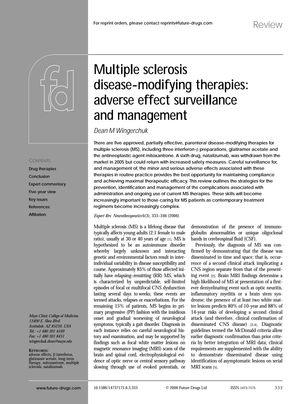Multiple Sclerosis Disease-Modifying Therapies: Adverse Effect Surveillance and Management
March 2006
in “
Expert Review of Neurotherapeutics
”

TLDR The document concludes that managing side effects of MS therapies is crucial for treatment success and patient adherence.
The 2006 document reviewed the adverse effects and management strategies for the five approved disease-modifying therapies for multiple sclerosis (MS) at the time: interferon-ß (IFN-ß) preparations, glatiramer acetate, and mitoxantrone, and also discussed the withdrawn drug natalizumab. It highlighted the importance of managing adverse effects to maintain patient compliance and maximize therapeutic efficacy. IFN-ß was shown to reduce clinical exacerbations and new lesions, with strategies provided to manage side effects such as flu-like symptoms, injection site reactions, leukopenia, and liver function abnormalities. Glatiramer acetate was well-tolerated but had uncertain long-term efficacy, with side effects including injection site reactions and potential lipoatrophy. Mitoxantrone was effective but limited by cardiotoxicity and other risks, necessitating careful monitoring. Natalizumab was withdrawn due to progressive multifocal leukoencephalopathy (PML) risks but was under consideration for reintroduction with a safety plan. The document underscored the need for vigilant surveillance for serious medical complications and careful risk-benefit analysis of therapies like natalizumab.



